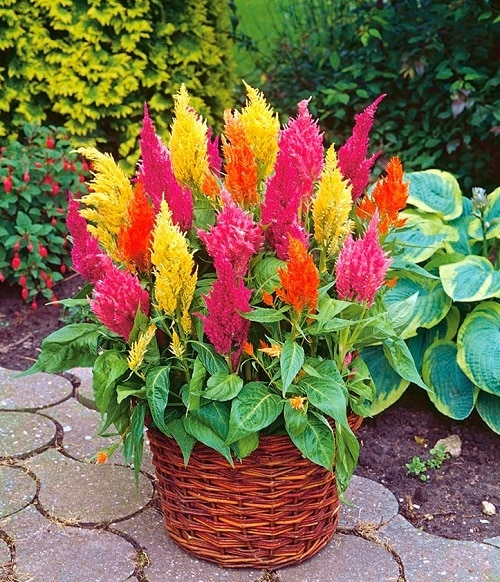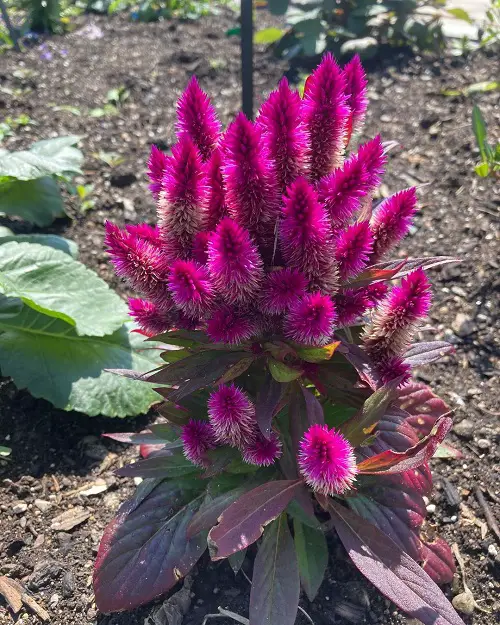With a beautiful and stunning array of flowers, this plant is a sure delight! Here’re all the details on How to Grow Celosia and Its Care!

Here to learn How to Grow Celosia? From sowing the seeds to maintaining proper spacing and watering, this guide will help you with Celosia how to plant and successfully nurture Celosia plants for vibrant and beautiful blooms.
USDA Zones: 10-12, 2-9 (As an Annual)
Common Names: Woolflower, Silver Cockscomb, Quail Grass, Cockscomb
Celosia Plant Information
Celosia is believed to have originated in Africa, specifically in regions such as Nigeria, Sudan, and Ethiopia. Wild species of Celosia can still be found growing in these areas. From Africa, Celosia spread to other parts of the world through trade and cultivation.
Celosia plants are known for their unique and vibrant flower heads. The flowers can come in various forms, including plumed, crested, or wheat-shaped flower heads. Plumed varieties have feathery, upright flower spikes resembling flames or rooster combs, while crested varieties have a rounded, brain-like appearance. The flower heads can be large or small, depending on the cultivar.
The colors of Celosia flowers are diverse and eye-catching, ranging from shades of red, pink, orange, yellow, and purple. Some varieties even exhibit multicolored or variegated blooms. The foliage of Celosia plants is typically green and may have a slightly glossy texture.
In addition to their ornamental value, Celosia plants have other uses. In some cultures, the flower heads and young leaves are edible and used in various culinary preparations. Celosia flowers are also popular as dried flowers for crafts and floral arrangements.
Here are Stunning Types of Celosia You Can Grow
Propagating Celosia Plants

Don’t know How to Grow Celosia? We’ve got you covered. You can propagate wool flowers from cuttings and seeds.
From Cuttings
- Take a 5-6 inches long cutting from a healthy plant with at least 2-3 leaf nodes.
- Strip all the bottom leaves with a few remaining on top.
- Place the cutting in the soil. Keep it where it can get bright, indirect daylight.
- Once it forms roots (2-4 weeks) and begins to grow, transplant the cuttings into the desired place.
From Seeds
- Get the seeds of your favorite Celosia variety.
- Sow them 1/3 to 1/4 inches (0.6 to 1 centimeter) deep in a seed tray or pot that has a well-draining soilless mix.
- Keep the soil moist and place the pot in bright light.
- Ensure the soil temperature is above 64°F (18°C), but you can start them when the temperature is as low as 60°F (15°C).
Find How Vinegar Improves Seed Germination (Proven by Science) here
Celosia when to plant: You should Start propagation from April in subtropics and slightly cooler climates. If you live in a cold place, wait till mid-may; seed sowing can be done till July and beyond if temperature requirements are satisfied. In a hot climate (USDA Zone 10-12), wait till the summer ends – you can also grow them in spring or fall. In moderate climates, you can start planting in spring.
Best Pot Size for Growing Celosia

Don’t know How to Grow Celosia in pots? You should select a pot that has a diameter of at least 8 inches. This size provides enough space for the roots to spread out and allows for proper drainage.
However, if you want your Celosia plants to grow larger or if you’re planning to grow multiple plants in the same container, you may opt for a larger pot size. A pot with a diameter of 10 to 12 inches (25 to 30 centimeters) would be suitable for this.
If you’re looking to grow Celosia plants in hanging baskets or window boxes, a pot size of 6 to 8 inches can be used, ensuring proper drainage holes are present to prevent waterlogging.
Here are Plant Pot Sizes from Inches to Gallon
Requirements for Growing Celosia

Location – Celosia Where to Plant
Celosia plants thrive in full sun to partial shade conditions. Confused about Celosia where to plant? It is important to choose a location that receives at least 6 to 8 hours of direct sunlight per day for optimal growth and blooming.
If you live in a region with extremely hot summers, providing some afternoon shade can help protect the plants from excessive heat.
Soil
Celosia plants prefer well-draining soil that is rich in organic matter. A fertile soil mixture with good moisture retention is ideal for their growth. You can improve the soil quality by adding compost or well-rotted manure before planting.
Here are the best recipes to make the perfect growing medium for your plants
Avoid heavy clay soils that can cause waterlogging and hinder root development.
Watering
Celosia plants require regular watering to keep the soil evenly moist but not waterlogged. Water them deeply whenever the top inch of the soil feels dry to the touch.
Be mindful not to overwater, as excessive moisture can lead to root rot. During hot and dry periods, more frequent watering may be necessary to prevent wilting.
Here are Signs of Overwatering & How to Save an Overwatered Plant
Temperature and Humidity
Celosia plants thrive in warm temperatures. They prefer a temperature range of 70 to 85°F (21 to 29°C) during the day and around 60 to 70°F (15 to 21°C) at night. They are sensitive to frost, so it is important to plant them after the last frost date in your region.
Celosia plants can tolerate moderate humidity levels, but high humidity combined with poor air circulation can increase the risk of fungal diseases. Adequate spacing between plants and good ventilation can help prevent such issues.
Celosia Plant Care

Fertilizer
Fertilize the plant using a liquid fertilizer with an NPK ratio of 15-30-15 or 10-10-10 once a month. When the plant starts to flower, increase the fertilization frequency to once every 2-4 weeks.
Here are the Best DIY Potassium Fertilizer Recipes
Begin fertilizing when the plants have established a good root system, usually about two to three weeks after planting. Avoid over-fertilization, as it can lead to excessive foliage growth at the expense of flowering.
Pruning
Celosia plants generally do not require extensive pruning. However, removing spent flowers, also known as deadheading, can encourage continuous blooming and prevent the plants from diverting energy to seed production. Simply pinch or cut off the faded flowers at their base.
If your Celosia plants become leggy or develop weak stems, you can perform a light pruning by cutting back one-third of their height to promote bushier growth.
Pests and Diseases
Common pests and diseases that infect celosia plants are aphids and spider mites. For diseases, check for leaf spot, stem, and root rot.
To avoid infection–keep your plant healthy, water within the limit, and ensure good drainage. Spray with organic pesticide and fungicide if necessary.
Keep an eye out for signs of powdery mildew, a fungal disease that appears as a white, powdery coating on the leaves. If your potted celosia plant begins to wilt and grows up with difficulty, it is a sign of excessive watering or fertilizing. Planting in well-draining soil or a soilless potting mix and fertilizing according to the instructions will fix these problems.



I want to know if you can grow Celosia Flamingo Feather Plants from cuttings. A nice piece broke off accidentally
from my young plant.
Thank You. Your Web Site is very nice.
I have rooted cuttings of plumed celosia with good success. I did 5 cuttings in water in a sun room and all rooted. They sent out a long, single root and then feeder roots came later. These cuttings rooted anywhere from 2 to 4 weeks. Three rooted in about 2 weeks and the last 2 took about 4 weeks. Stems were healthy throughout the rooting process.
I also tried 5 cuttings in sand. They also took about the same time to root but I had them outside where they got shade during the hottest part of the day. I kept the sand moist by setting the pot in a pie plate and put a milk jug over the top to hold humidity. On some days when there was intense heat, I watered the pot. I checked 2 of the cuttings today and they had roots and in more abundance than the cuttings in water. I will pot them up tomorrow.
From my experience, they are easy rooters and I did not use any rooting aid. I used side shoots from the ‘mother’ plant about 4 inches long. Pinched off any buds and took off the bottom leaves leaving only about 3 or 4. The cuttings with the 4 leaves seemed to have the better root system.
I am looking forward to growing this celosia in a pot this winter. It is very pretty. Should I pay attention to the size of the pot and the plant. are they easy to transplant?
I like celosia becoz i m floriculturist azalea camelia also my favourite
I have had 3 of them in my dart frog vivarium for the last year and a 1/2 in their still growing beautiful with the heat and humidity around 83 degrees
as it winter would it be best to get my plant in till the summer
I have found they thrive in larger, shallow round pots! Leave room for them to spread.